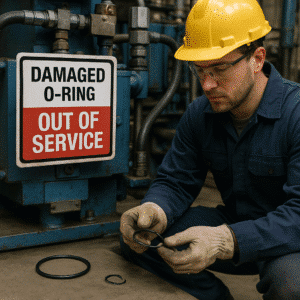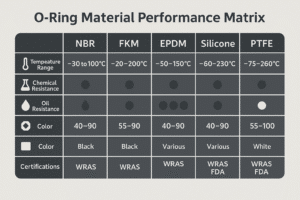Installing an oil seal incorrectly can lead to premature failure, oil leakage, and costly downtime. Whether you're replacing a crankshaft seal or mounting a rotary shaft seal, proper oil seal installation is critical.
In this guide, I’ll show you how to install oil seals the right way—without damaging the lips or misaligning the casing. This article covers tools, step-by-step procedures, lip direction, sealing surface prep, and tips for ensuring long-lasting performance.
What tools are needed for oil seal installation?
You don’t need an entire workshop—but using the right tools makes all the difference.
| Tool | Function |
|---|---|
| Oil Seal Installer / Press Tool | Applies even pressure without damaging the seal |
| Rubber Mallet | Gentle tap-in if installer tool not available |
| Cleaning Solvent | Preps shaft surface for sealing |
| Lubricant (e.g. engine oil) | Helps the seal slide into place |
| Flathead Screwdriver / Pick | Removes old seal carefully |
| Micrometer / Caliper | Verifies shaft and bore size match |
Some kits include their own installer. You can also choose a universal press tool when ordering replacement seals like our TG4 oil seal.
What direction should the oil seal face to prevent leaks?
Installing backward is the most common mistake.
- Main sealing lip always faces the fluid or oil side (inward)
- Dust lip (if any) faces outward, toward contaminants
For skeleton seals like TG4 or TC oil seal, inspect the lip curvature: the spring side always faces oil.
How to install an oil seal without leaks: full process
-
Remove the old seal
Use a puller or flat screwdriver. Avoid damaging the housing. -
Clean bore and shaft
Remove oil, dirt, and rust using solvent and lint-free wipes. -
Inspect shaft
Look for scratches or grooves—polish lightly if needed. -
Lubricate lips
Apply a thin coat of oil or grease—never install dry. -
Align the new seal
Center it squarely over the bore opening. -
Press or tap in evenly
Use a seal installer or socket. Do not hammer the center. -
Confirm flush seating
Outer edge should be level or slightly recessed—not protruding. -
Double-check orientation
Ensure the spring side faces oil and dust lip faces out.
Working on more complex components? Check our Crankshaft Oil Seal Replacement Guide for deeper instructions.
Can damaged oil seals be reused?
Never reuse old or deformed oil seals—even minor lip damage leads to leaks. Replacement is essential, especially when servicing timing covers or differentials.
We stock quality replacement seals in NBR and FKM, including OEM types. Explore our TC and TG4 options.
Do you need sealant when installing oil seals?
Usually, no — but exceptions include:
| Condition | Sealant Required? |
|---|---|
| Smooth metal bore | ❌ No |
| Worn or oversize housing | ✅ Use Loctite or flange sealant |
| Static rubber-coated seals (TG4) | ❌ No |
| High-vibration areas | ✅ Light non-hardening sealant on outer edge |
Avoid getting sealant on the lip.
Conclusion
Correct oil seal installation ensures leak-free performance and longer service life. Use the right tools, align lips correctly, and never install dry.
Ready for high-quality oil seal replacements?
We offer durable NBR and FKM shaft seals in all sizes. OEM and custom orders supported.
📧 Email: [email protected]
📱 WhatsApp: +86 17622979498
Related topics
TC Skeleton Oil Seal – Metal Shell
TG4 Double-Lip Rotary Oil Seal
Crankshaft Oil Seal Replacement Guide


